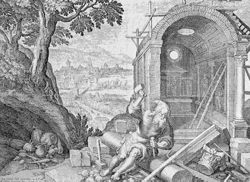Saint Marinus
| Saint Marinus | |
|---|---|
 | |
| Died | 366 (traditional) |
| Venerated in | Roman Catholic Church |
| Major shrine | Basilica of Saint Marinus |
| Feast | September 3 |
| Attributes | Depicted as a bearded layman with a stonemason's hammer; also depicted as a young deacon with a hammer; depicted serving as a deacon to Saint Leo the Great or Gaudentius of Rimini; two oxen near him. |
| Patronage | San Marino |
Saint Marinus was the founder of a chapel and monastery, in 301, from where the world's oldest surviving republic, San Marino, grew. Tradition holds that he was a stonemason by trade who came from the island of Rab, on the other side of the Adriatic Sea (in what is now part of modern Croatia), fleeing persecution for his Christian beliefs in the Diocletianic Persecution. Still known only by the single name Marinus (lit. of the sea), he became a Deacon, and was ordained by Gaudentius, the Bishop of Rimini; later, he was recognised and accused by an insane woman of being her estranged husband, so he quickly fled to Monte Titano to build a chapel-monastery and live as a hermit.[1] There he built a chapel and monastery. Marinus was canonised as a saint, and later, the State of San Marino grew up from the centre created by the monastery.[1] His feast day/memorial day is 3 September, commemorating the day, in 301, when he founded what became known as San Marino, which is also the state's national holiday. He is venerated solely in the Roman Catholic Church.
According to legend, he died in the winter of 366 and his last words were: "Relinquo vos liberos ab utroque homine" ("I leave you free from both men"). This somewhat mysterious phrase is most likely to refer to the two "men" from whose oppressive power Saint Marinus had decided to separate himself, becoming a hermit on Mount Titano: respectively the Emperor and the Pope. This affirmation of freedom (first and foremost fiscal franchise) from both the Empire and the Papal States, however legendary, has always been the inspiration of the tiny republic.[2]
See also
References
External links
- Saints of September 4: Marinus of San Marino, Hermit Deacon (on this website, September 4 is incorrectly indicated as Saint Marinus' day)
- Patron Saints Index: Saint Marinus
- (in Italian) San Marino